How to Resolve 0x800710FE when Trying to Delete a File
Some Windows users are encountering the 0x800710FE (This file is currently not available for use on this computer) when attempting to delete a file or folder. The issue is not OS-specific, but it seems to mostly occur with files and folders that we’re generated by 3rd party security suites.
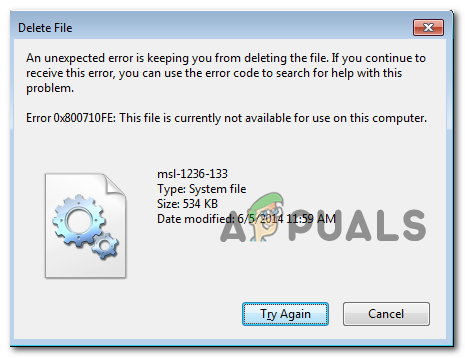
By far, the most common instance that will be responsible for the apparition of the 0x800710FE error is the native Office File Synchronization (that is present on every recent Windows version, but it’s not enabled by default).
If you’re technical, you can prevent the error from re-appearing by accessing the Sync Center settings via the Classic Control panel and disabling Offline Files or by running a series of commands inside an elevated CMD prompt.
In case the issue is caused by a CSC database glitch, you can fix the issue by creating a FormatDatabase key using Registry Editor.
However, the issue can also be caused by logical errors on your drive – In this case, a CHKDSK scan should resolve the issue automatically. If the file is encrypted or your user doesn’t have the permission to edit it, one way that will allow you to delete it is to boot from a LIVE USB Ubuntu drive and delete it via the terminal.
Method 1: Disable Offline File Synchronization
As it turns out, in most cases, this particular issue is caused by a file or dependencies associated with Offline File Synchronization.
If this scenario is applicable, you should be able to fix the issue by using the Classic Control Panel interface to access the Sync settings and disabling Offline Files from the Manage Offline Files menu.
Here’s a quick guide on how to do this:
Note: The instructions below should be applicable regardless of the Windows version that you’re encountering the issue on.
- Press Windows key + R to open up a Run dialog box. Inside the text box, type ‘control’ and press Enter to open up the classic Control Panel interface.
- Once you’re inside the classic Control Panel interface, use the search function (top-right section) to search for ‘sync center‘ and press Enter.
- Then, double-click on Sync Center from the list of results.
- Next, from the left-hand side menu, click on Manage offline files.
- Once you’re inside the Offline Files menu, select the General tab and click on Disable offline files.
- When prompted by the UAC (User Account Control), click Yes to grant admin access.
- After Offline Files feature is disabled, repeat the action that was previously causing the 0x800710FE

In case you’re still encountering the same error or Offline features was already disabled, move down to the next potential fix below.
Method 2: Formatting CSC Database via Registry Editor
If disabling file synchronization didn’t work for you, the next logical step would be to use Registry Editor to create a FormatDatabase key that will allow you to reset any cluster of data that might trigger the 0x800710FE due to permission issues.
Several affected users have confirmed that the issue was swiftly resolved and the This file is currently not available for use on this computer error no longer occurred after they followed the instructions below and restarted their computer.
Here’s a quick guide that will allow you to format the CSC database via Registry Editor:
- Open up a run dialog box by pressing Windows key + R. Next, type ‘regedit’ inside the text box and press Enter to open up Registry Editor. When you’re prompted by the UAC (User Account Control), click Yes to grant administrative privileges.
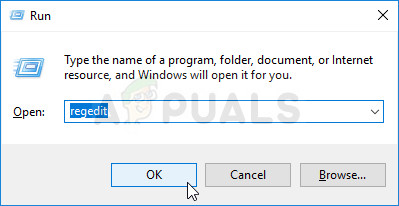
Running the Registry Editor - Once you’re inside the Registry Editor, use the left-hand side menu to navigate to the following location:
HKEY_LOCAL_MACHINE\System\CurrentControlSet\Services\CSC
Note: You can also get there instantly by pasting the location directly into the navigation bar and pressing Enter.
- After you manage to arrive at the correct location, move over to the right-hand side menu. Once you’re there, right-click on an empty space and choose New > Dword (32-bit) value.
- Name the newly created Dword value ‘FormatDatabase’, then double-click on it to modify it.
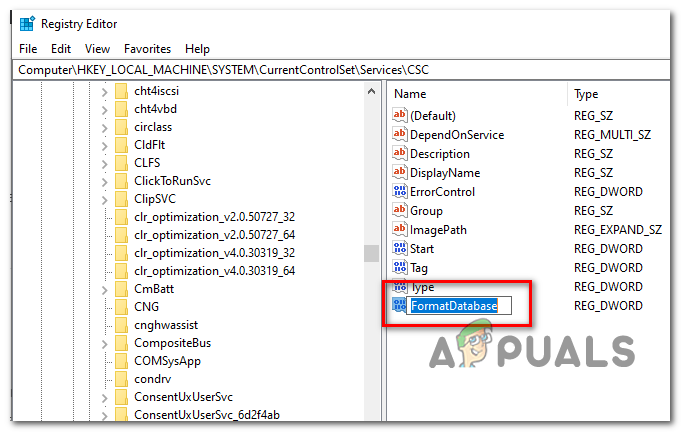
Creating the FormatDatabase menu - Inside the Edit DWORD (32-bit) Value window associated with FormatDatabase, set the Base to Hexadecimal and the Value Data to 1. Then, click Ok to save the changes.
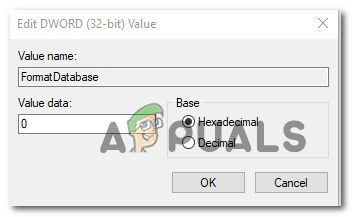
Configuring the FormatDatabase registry value - After the modification is complete, close the Registry Editor and restart your computer to see if the issue has been resolved.
In case the same problem is still occurring and you’re still prevented from deleting certain files by the 0x800710FE error, move down to the next potential fix below.
Method 3: Disabling Sync Center via CMD
As it turns out, one of the most common features that will end up causing this 0x800710FE (This file is currently not available for use on this computer) is the Sync Center. Even though this feature should not be enabled by default, you might find this scenario applicable in case you previously established a synced partnership (you made some network files or folders available offline).
If one of those files/folders part of this shared partnership ends up causing the 0x800710FE, you can most likely get the issue resolved by disabling the Sync Center driver and service, clearing the Client-Side Cache, disabling the scheduled tasks and preventing the Sync Center from starting at every logon.
A lot of users encountering this issue have reported that the issue went away and they were able to delete the folder after following the instructions below and restarted their computer.
Here’s a quick guide on disabling the Sync center in order to resolve the 0x800710FE error code:
- Press Windows key + R to open up a Run dialog box. Inside the text box, type ‘cmd’ and press Ctrl + Shift + Enter to open up an elevated CMD prompt. When you see the UAC (User Account Control), prompt, click Yes to grant admin access.

Running the Command Prompt - Inside the elevated CMD prompt, type the following command and press Enter in order to disable the driver and service associated with the Sync Center:
for %G in ("CSC","CscService") do sc config "%~G" start= disabled - In the same CMD window, type the following commands and press Enter after each one to clear the Client-Side Cache (CSC):
takeown /f "%windir%\CSC" /a /r icacls "%windir%\CSC" /grant:r *S-1-5-32-544:F /t /c /q icacls "%windir%\CSC" /grant:r *S-1-5-18:F /t /c /q for /d %G in ("%windir%\CSC\v2.0.6\namespace\*") do rd /s /q "%~G" - Once every command is processed successfully, type the following commands and press Enter after each one to disable the scheduled tasks associated with the Sync Center:
schtasks /change /tn "\Microsoft\Windows\Offline Files\Background Synchronization" /disable schtasks /change /tn "\Microsoft\Windows\Offline Files\Logon Synchronization" /disable
- And finally, prevent the Sync Center from starting at every log on by running the following commands and pressing Enter after each one:
reg add "HKCU\Software\Classes\Local Settings\Software\Microsoft\Windows\CurrentVersion\SyncMgr" /v "StartAtLogin" /t REG_DWORD /d 0 /f reg add "HKCU\Software\Classes\Local Settings\Software\Microsoft\Windows\CurrentVersion\SyncMgr\HandlerInstances\{750FDF10-2A26-11D1-A3EA-080036587F03}" /v "Active" /t REG_DWORD /d 0 /f reg delete "HKCU\Software\Microsoft\Windows\CurrentVersion\SyncMgr" /f reg delete "HKCU\Software\Classes\Local Settings\Software\Microsoft\Windows\CurrentVersion\NetCache" /f reg delete "HKCU\Software\Classes\Local Settings\Software\Microsoft\Windows\CurrentVersion\SyncMgr\HandlerInstances\{750FDF10-2A26-11D1-A3EA-080036587F03}\SyncItems" /f - Once every command is successfully processed, close the elevated CMD prompt and restart your computer.
- At the next startup sequence, attempt to delete the folder or file that was triggering the error and see if the problem is now fixed.
In case you’re still encountering the 0x800710FE (This file is currently not available for use on this computer), move down to the next potential fix below.
Method 4: Deleting file via USB Ubuntu drive
If none of the other methods above have allowed you to fix the issue, you should try creating a USB Live ubuntu drive and boot from it in order to remove the file or folder that is causing the 0x800710FE (This file is currently not available for use on this computer).
Several affected users that have tried this fix and performed a CHKDSK afterward have reported that they’ve successfully managed to get rid of the file or folder that was refusing to go conventionally.
Here’s a quick guide on creating a Live Ubuntu USB drive on Windows and boot from it in order to delete the folder or file that’s triggering the 0x800710FE:
- Visit this link (here) and download the latest ISO image of Ubuntu. It’s recommended that you download the LTS version if possible. Just click on the Download button once you get to the correct page.
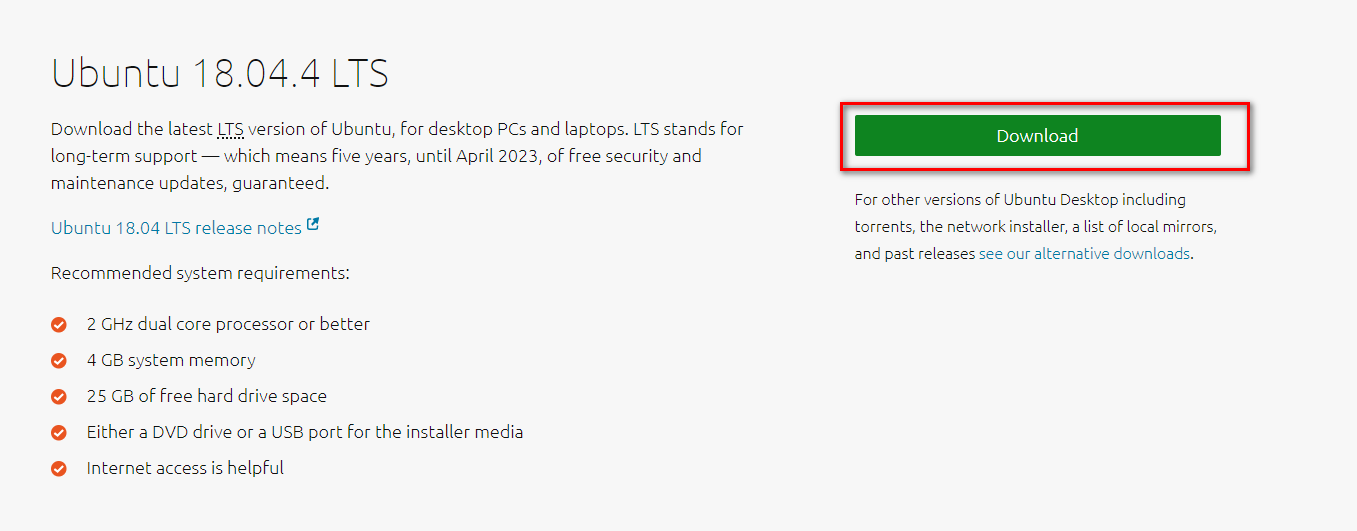
Downloading the latest Ubuntu version - While the Ubuntu image is downloading, visit this link (here) and download the latest version of the Universal USB Installer via the Download UUI button. Find it by scrolling down the page.
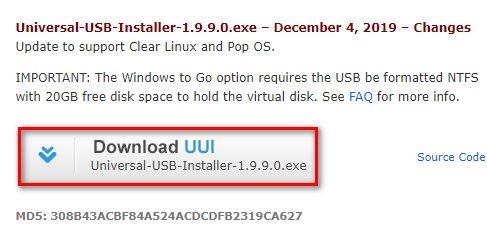
Downloading the latest version of the Universal USB Installer - Insert a flash disk that you plan on using as the Ubuntu Live image. Make sure to backup any important data on it, since the next procedure will end up formatting the drive.
- After the installation executable of UUI is downloaded, double-click on it, accept the License Agreement, then follow the on-screen instructions to complete the installation.

Agreeing with the Universal USB installer - At the next screen, choose Ubuntu via the drop-down menu (under Step 1), then click on Browse (associated with Step 2) and select the .ISO image that you downloaded at step 1.
- Next, use the drop-down menu associated with Step 3 to select the drive you want to install the live Ubuntu image on.
- After you select the drive, ensure that you check the box associated with Fat32 Format Drive. Once you are ready to go, click on Create and wait for the process to complete.

Creating the Ubuntu Live Image - After the process is complete, restart your computer and boot from the USB drive at the next system startup by pressing the key associated with entering your boot menu (most commonly F2, F10, and F12). Once you get to the Boot Menu, select your flash drive to boot from your Ubuntu live image.
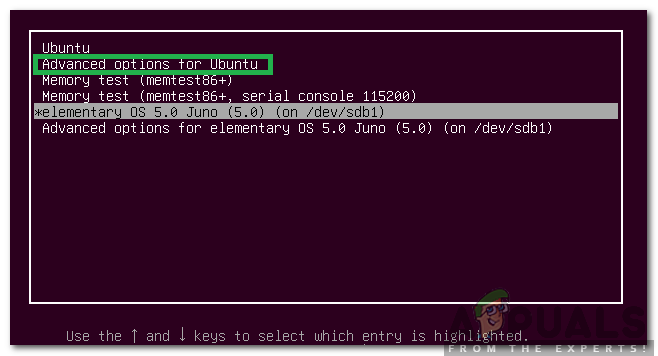
Selecting Advanced Options for Ubuntu - Wait until your computer boots from the Ubuntu live image, open a Terminal and type the following command and press Enter to remove the directory that was previously triggering 0x800710FE:
rm -r MyDirectory
Note: Keep in mind that MyDirectory is simply a placeholder. Be sure to replace it with the exact location that you want to delete.
- After you manage to delete the file or folder from within the Ubuntu Live image, restart your computer and ensure that you boot from your HDD or SSD at the next startup by removing the Ubuntu live flash drive as soon as you get past the initial screen.
In case you did follow the instructions above, it’s highly recommended that you also perform a CHKDS scan. Do this by following the next method below.
Method 5: Performing a CHKDSK scan
Since using a Ubuntu Live image to delete a directory is known to open to create bad sectors and metadata corruption, it’s very important to eliminate this complimentary issue as soon as possible.
Fortunately, Windows includes a built-in utility (CHKDSK) that is capable of scanning for errors and corruptions and repair any logical errors and corrupted data that a forceful deletion attempt might have left behind.
CHKDSK (Disk Error Checking utility) on Windows 10 is much more efficient than previous iterations, but in order to ensure that it has the necessary permissions to repair the bad files, you will need to ensure that it’s opened into an elevated CMD window.
In case you don’t know how to start a CHKDSK scan & repair process, follow this guide here on running CHKDSK.
Note: The instructions should work regardless of which Windows version you’re encountering the issue on.





